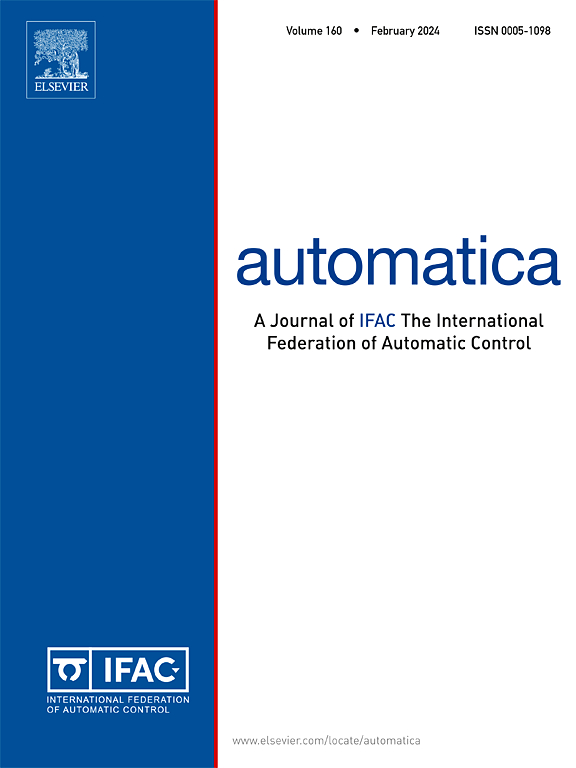部分欠驱动网络化2自由度柔性关节机械臂的分布式末端执行器编队控制
IF 5.9
2区 计算机科学
Q1 AUTOMATION & CONTROL SYSTEMS
引用次数: 0
摘要
存在故障或欠驱动的机械手会破坏末端执行器的队形保持。研究了具有柔性关节的平面网络化双连杆机械臂的分布式末端执行器编队控制问题,重点研究了部分机器人欠驱动的情况。欠驱动的agent可以是主动-被动(AP)机械手,其中只有第一个关节被驱动;被动-主动(PA)机械手,其中只有第二个关节被驱动;或者两者的组合。首先,我们建立了所讨论的柔性关节欠驱动机械臂的平衡性质。基于这一特性,我们引入了机器人虚拟末端执行器的新概念,其位置在控制器设计中充当中间变量。然后,我们扩展了基于距离和基于位移的编队控制器,通过耦合虚拟末端执行器来适应这组机械手,而不是现有工程中使用的实际末端执行器。最后,我们研究了网络化末端执行器的期望和可达形状集,以突出欠驱动机械手的存在如何影响所提出控制器的适用性。该分析表明,基于距离的方法比基于位移的方法在组中容纳更多的欠驱动机械手。我们通过数值模拟验证了我们的分析和所提出的分布式控制器。本文章由计算机程序翻译,如有差异,请以英文原文为准。
Distributed end-effector formation control for networked 2-DoF flexible-joint manipulators with partially underactuated agents
The presence of faulty or underactuated manipulators can disrupt the end-effector formation keeping of a team of manipulators. This paper investigates the distributed end-effector formation control of networked planar two-link manipulators with flexible joints, emphasizing cases where some agents are underactuated. The underactuated agents can be active–passive (AP) manipulators, where only the first joint is actuated; passive–active (PA) manipulators, where only the second joint is actuated; or a combination thereof. First, we establish an equilibrium property for the discussed underactuated manipulators with flexible joints. Building upon this property, we introduce the novel concept of virtual end-effectors for manipulators, whose positions serve as intermediate variables in the controller design. Then, we extend the distance-based and displacement-based formation controllers to accommodate this group of manipulators by coupling virtual end-effectors, rather than actual end-effectors used in existing works. Finally, we investigate the set of desired and reachable shapes for the networked end-effectors to highlight how the presence of underactuated manipulators affects the applicability of the proposed controllers. This analysis demonstrates that the distance-based method accommodates more underactuated manipulators in the group than the displacement-based method. We validate both our analysis and the proposed distributed controllers through numerical simulations.
求助全文
通过发布文献求助,成功后即可免费获取论文全文。
去求助
来源期刊

Automatica
工程技术-工程:电子与电气
CiteScore
10.70
自引率
7.80%
发文量
617
审稿时长
5 months
期刊介绍:
Automatica is a leading archival publication in the field of systems and control. The field encompasses today a broad set of areas and topics, and is thriving not only within itself but also in terms of its impact on other fields, such as communications, computers, biology, energy and economics. Since its inception in 1963, Automatica has kept abreast with the evolution of the field over the years, and has emerged as a leading publication driving the trends in the field.
After being founded in 1963, Automatica became a journal of the International Federation of Automatic Control (IFAC) in 1969. It features a characteristic blend of theoretical and applied papers of archival, lasting value, reporting cutting edge research results by authors across the globe. It features articles in distinct categories, including regular, brief and survey papers, technical communiqués, correspondence items, as well as reviews on published books of interest to the readership. It occasionally publishes special issues on emerging new topics or established mature topics of interest to a broad audience.
Automatica solicits original high-quality contributions in all the categories listed above, and in all areas of systems and control interpreted in a broad sense and evolving constantly. They may be submitted directly to a subject editor or to the Editor-in-Chief if not sure about the subject area. Editorial procedures in place assure careful, fair, and prompt handling of all submitted articles. Accepted papers appear in the journal in the shortest time feasible given production time constraints.
 求助内容:
求助内容: 应助结果提醒方式:
应助结果提醒方式:


